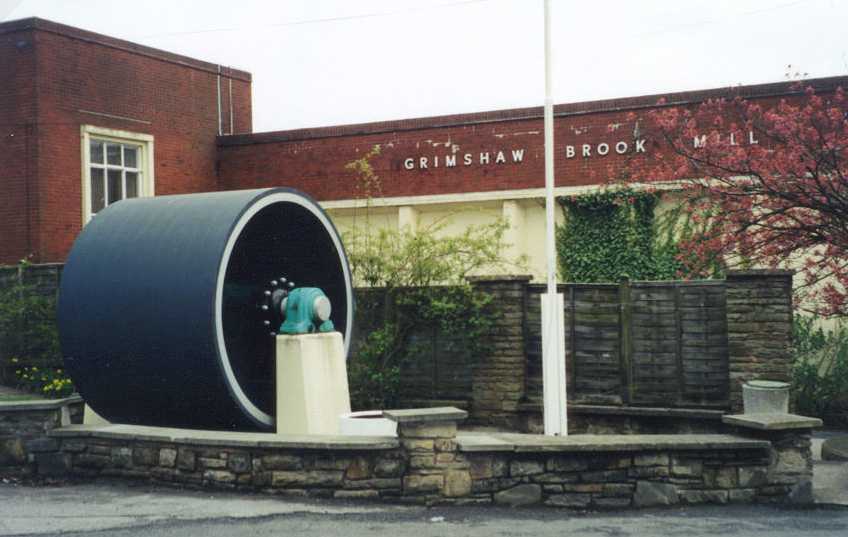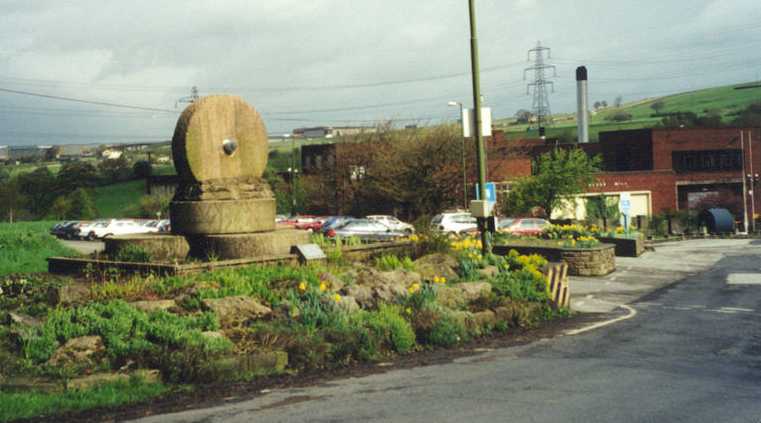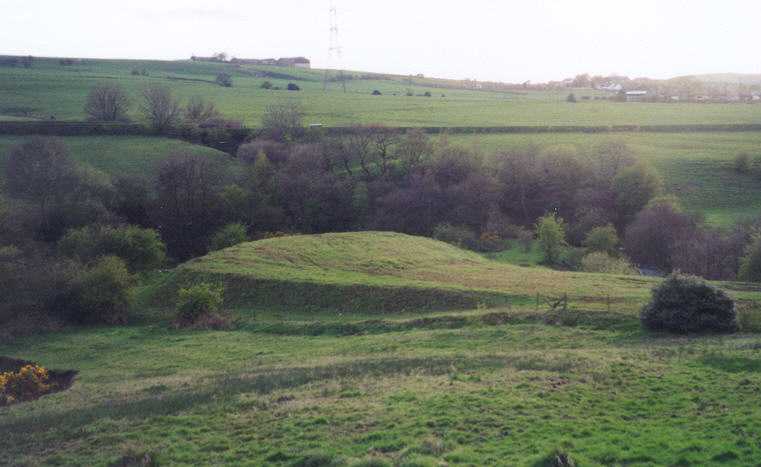Industrial Development
at the Grimshaw Location in Eccleshill
Perhaps fittingly (given the depth of involvement of the family in the early development of the Industrial Revolution), the original Grimshaw location in Eccleshill was given over to an industrial site at an early date, first as a water-powered cotton mill in 1782 and then as a paper mill from 1872 to 1999. The paper mill is now closed, but an adjacent envelope factory continues in operation.
Contents
Industrial
Beginning as Cotton MillThe Grimshaw Mill Was Attacked in the 1826 Power Loom Riots
Paper Mill Artifacts at the Grimshaw Location
Photos of Envelope Factory and Paper Mill Artifacts
Photo of Landfill on Grimshaw Brook near Paper Mill
Industrial Beginning as a Cotton Mill
The earliest industry at the Grimshaw location in Eccleshill was apparently started there in order to take advantage of the water power of Grimshaw Brook for processing cotton. Development at the location began in about 1782, when a water-powered carding and spinning factory was built. Steam power was later added, and the mill was used for processing cotton until 1872.
The 1846 Ordnance Survey “Six-Inch” map shows Grimshaw Bridge crossing Grimshaw Brook, and Grimshaw Bridge Factory (Cotton) is shown just east of the brook (on the Pickup Bank side). Another cotton mill, Water Side Mill, is shown about one-half mile upstream from Grimshaw, and other mills can also be seen on the map.
The Grimshaw Mill Was Attacked in the 1826 Power Loom Riots
Apparently the power loom riots of April 26 to 28, 1826 (see companionwebpage) reached the Grimshaw cotton mill, as described in the following newspaper article1 (see last paragraph and, in particular, the second to last sentence):
Conversion to a Paper Mill
In 1872, the old cotton mill site was converted to a paper mill. A large envelope factory, called Grimshaw Brook Mill, was added after World War II. The paper mill has been closed (but remains standing), apparently in 1999, but the envelope operation is still active. A “backside” photoof the envelope factory and paper mill from Belthron is given on another webpage. A picture of the Grimshaw Brook Mill is shown near the bottom of this webpage.
Additional detail on the history of the industrial use of the Grimshaw location for a cotton mill and paper mill is given in the description1 of the industrial archeology of Darwen, Eccleshill and surrounding area; the site description is given at the bottom of this webpage.
Paper Mill Artifacts at the Grimshaw Location
The company that operated the paper mill placed two historical pieces of paper-making equipment still at Lower Grimshaw; they are shown near the bottom of this webpage, below the Grimshaw Brook Mill photo. The piece at the entrance to the site is a “Kollergang Stone”, dating from about 1900, which is described as follows on a sign below the stone:
This stone was used for grinding wastepaper and rag pulp in preparation for the early process of paper manufacture. It was part of the original equipment at the Waterside Paper Mill, Darwen, Lancs. when this mill was purchased by Chapman & Co (Balham) Limited in 1937.
The equipment near the building is a paper making cylinder which is described as follows:
This M.G. paper making cylinder was manufactured in 1888 by Bentley & Jackson Ltd., Bury, and is believed to be the oldest cylinder of its kind in the world. Originally supplied to a Mr. J.L. Hastings. No records are available of its history till 1931 when Henry Cooke & Co (1932) Ltd. took over “The Falls Paper Mills” at Milnthorpe, Westmorland where it was already installed. In 1940 it was acquired by “The New Waterside Paper Mills Ltd.” and used for making envelope M.G. papers and cellulose wadding continuously throughout the Second World War till 1956 and thereafter as a predryer till 1967.
Another legacy of the industrial heritage of the Grimshaw location – a solid waste landfill that is located on Grimshaw Brook just upstream of the paper mill and envelope factory. A photo of it is included near the bottom of this webpage.
Photos of Grimshaw Brook Envelope Factory and Paper Mill Artifacts
This picture shows the Grimshaw Brook Mill with a former paper-making cylinder in front. Photo taken westward, in March 1999.

This lower photo is of the “Kollergang Stone”, which is located at the entrance to the site. Note Grimshaw Brook Mill and paper-making cylinder of upper photo on the right side of this photo. This photo can also be compared with the picture of the Grimshaw site taken from Belthorn – the smokestack and the Kollergang stone can be seen in both photos if you look carefully. Photo taken westward, in March 1999.

Photo of Landfill Near Paper Mill at Grimshaw Location
This picture shows another legacy of the industrial heritage of the Grimshaw location – a solid waste landfill that is located on Grimshaw Brook just upstream of the paper mill and envelope factory. The tree-lined brook can be seen just behind the landfill.

Additional Description of the Mills at the Grimshaw Location
The industrial archeological description2 of Darwen, Eccleshill and the surrounding region provides an in-depth description of the use of the Grimshaw location for a cotton mill and paper mill. The two mills are described on pages 8 and 56-57, respectively.
Cotton Mill Description, p. 8:
Grimshaw Bridge Mill SD 708 242
An early water-powered carding and spinning factory, erected in 1782 by William Yates of Woodhead, and leased to Nathan Yates, a Belthom chapman and calico manufacturer.
Following Yates’ failure in l790, the mill was worked briefly by William Booth of Lower Darwen. By the early nineteenth century, Walmsley, Townsend & Green had taken over. In 1823, the surviving partner, Joseph Walmsley, was employing 23 hands at the mill. Walmsley, a mule spinner, appears to have been producing yarn for handloom manufacturers, perhaps on a commission basis.
During the rnid-1840’s an additional two storey block, equipped with a 10 hp engine, was erected. In 1850 this was leased to Cowell & Loynd who installed 120 power looms. John Loynd had been manager of Lower Darwen Mill.
In 1855 the Walmsley family retired from business and sold the plant, including three hand mules, of the original spinning mill. A year later Loynd failed, mainly as a result of a fire which gutted his premises.
The larger, three storey mill was leased to Holden Haworth, John Haworth & Joseph Clegg, hard waste spinners and manufacturers. Clegg withdrew in 1861 and John Haworth in 1863, both partners moving to Cocker Lumb Mill, Oswaldtwistle.
Loynd’s old budding was leased to a number of manufacturers, including Taylor & Haworth of Belthom, who ceased business during the Cotton Famine.
Holden Haworth moved to Vale Rock Mill, Hoddlesden, about 1869, and in 1872 Grimshaw Bridge was converted to paper making.
Site: for a description see Grimshaw Bridge Paper Mill.
Paper Mill Description, p. 56-57
Waterside or Grimshaw Bridge Paper Mill SD 708 242
An 1871-72 conversion of an older cotton spinning mill by the Grimshaw Bridge Paper Company Limited. Amongst the promoters were the Coulthurst brothers, machinists of Darwen, Walmsley Proctor and Thomas Beresford.
Plant included two paper machines manufacturing cap and biscuit papers. Power was provided by a water-wheel and horizontal engine.
The Grimshaw Bridge Paper Company Limited was wound up in 1877 and the mill was purchased by S.A. Nicholls, a former partner of Hope Mill. Part of the old cotton mill, used for finishing, was destroyed by fire in 1878, and about 1881 the works closed.
A second Grimshaw Bridge Paper Company Limited was formed in 1884 by S.A. Nicholls, William Almond, of South Belgrave, William Brooks of the Scotshaw Brook Paper Company, and others. Little production took place, and the n-tiu was again closed for a lengthy period.
Finally in 1889 the Waterside Paper Mill Company Limited was registered to operate the works. Production of cap and biscuit papers recommenced with one machine, and by 1892 two were in operation.
The mill was gutted by fire in 1914 and major rebuilding took place. Amongst the plant installed was a high speed engine by Ashworth & Parker, a British Thomson Houston dynamo, and a smaller high speed engine by Robertson of Darwen. The two paper machines were also reconstructed.
In 1937 the mill was purchased by C.H.Chapman of Belham to produce envelope papers, and in the following year the business was registered as New Waterside Paper MiUs Limited.
After World War Two the works was virtually rebuilt and a large envelope making factory was added to the site. Plant for the latter was supplied by Chapman’s engineering division.
Various companies were acquired by Chapman Industries during the 1970’s and 1980’s including Inversek Stationery of Edinburgh. In 1989 Chapman lndustries became a wholly owned subsidiary of a Swedish company.
Current plant includes two MG machines producing paper from waste and some wood pulp. Envelopes, many for HMSO, banks, mail order and public service companies, are made in Kraft, rnanilla, white and colours. A workforce of 200 is employed.
Site: The paper mill is situated on the south-east of the site. Facade, including offices and watch house, constructed of rustic brick with concrete details. At the rear is the machine house. Raw materials are stored at the southern (or wet end), with reeling and cutting rooms on the northern side.’ Some older sections of walling have survived the various reconstructions.
The envelope works is north-west of the paper mill and is principally built of rustic brick and concrete, with extensive glazing along the south-west wall.
To the rear is a modem boiler house with steel stack. A new cutting room is currently being erected.
Reference
1Author Unknown, 1826, By This Morning’s Mail, Latest From England: Salem, MA, Essex Register, v. 26, issue 46, page [3] (June 8, 1826) [Source: HeritageQuest Online at the following website:]
2Rothwell, Michael, 1992, Industrial Heritage – A guide to the Industrial Archeology of Darwen, Including Hoddleston, Yates & Pickup Bank, Eccleshill and Tockholes: Bridgestone Press, Printed by Caxton Printing Co., Accrington, 72 p.
Webpage History
Webpage posted August 2000. Updated February 2006 with additional clarification on the reference. Update July 2006 with newspaper article on loom riots.
